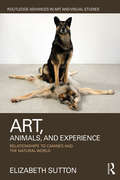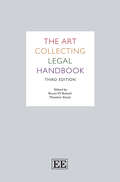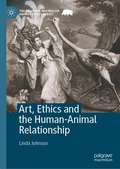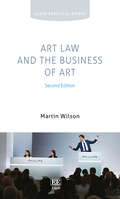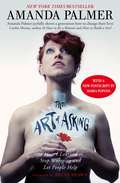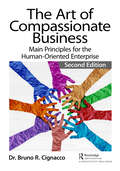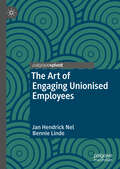- Table View
- List View
The Art and Science of Expert Witness Testimony: A Multidisciplinary Guide for Professionals
by Karen PostalFeaturing in-depth interviews of attorneys, judges, and seasoned forensic experts from multiple disciplines including psychology, medicine, economics, history, and neuropsychology, The Art and Science of Expert Witness Testimony highlights and offers bridges for the areas where the needs and expectations of the courtroom collide with experts’ communication habits developed over years of academic and professional training. Rather than seeing testimony as a one-way download from expert to jurors, The Art and Science of Expert Witness Testimony focuses on the direct, dynamic, unique communication relationship that develops as each juror’s lived experience interacts with the words of experts on the stand. This book expands the academic tradition of "methods-centered credibility" to also include "person-centered credibility," where warmth, confidence, and relentless attention to detail build trust with jurors. Seasoned forensic experts share what they actually say on the stand: their best strategies and techniques for disrupting traditional academic communication and creating access to science and professional opinions with vivid, clear language and strong visuals. The difficult but necessary emotional work of the courtroom is addressed with specific techniques to regulate emotions in order to maintain person-centered credibility and keep the needs of jurors front and center through cross-examination. This innovative compilation of research is essential reading for professionals and practitioners, such as physicians, engineers, accountants, and scientists, that may find themselves experts in a courtroom. The Art and Science of Expert Witness Testimony provides a unique experience for readers, akin to being personally mentored by over eighty-five attorneys, judges, and seasoned experts as they share their observations, insights, and strategies—not to "win" as a defense, prosecution, or plaintiff expert, but to be productive in helping jurors and other triers of fact do their difficult intellectual job in deciding a case.
The Art and Science of Expert Witness Testimony: A Multidisciplinary Guide for Professionals
by Karen PostalFeaturing in-depth interviews of attorneys, judges, and seasoned forensic experts from multiple disciplines including psychology, medicine, economics, history, and neuropsychology, The Art and Science of Expert Witness Testimony highlights and offers bridges for the areas where the needs and expectations of the courtroom collide with experts’ communication habits developed over years of academic and professional training. Rather than seeing testimony as a one-way download from expert to jurors, The Art and Science of Expert Witness Testimony focuses on the direct, dynamic, unique communication relationship that develops as each juror’s lived experience interacts with the words of experts on the stand. This book expands the academic tradition of "methods-centered credibility" to also include "person-centered credibility," where warmth, confidence, and relentless attention to detail build trust with jurors. Seasoned forensic experts share what they actually say on the stand: their best strategies and techniques for disrupting traditional academic communication and creating access to science and professional opinions with vivid, clear language and strong visuals. The difficult but necessary emotional work of the courtroom is addressed with specific techniques to regulate emotions in order to maintain person-centered credibility and keep the needs of jurors front and center through cross-examination. This innovative compilation of research is essential reading for professionals and practitioners, such as physicians, engineers, accountants, and scientists, that may find themselves experts in a courtroom. The Art and Science of Expert Witness Testimony provides a unique experience for readers, akin to being personally mentored by over eighty-five attorneys, judges, and seasoned experts as they share their observations, insights, and strategies—not to "win" as a defense, prosecution, or plaintiff expert, but to be productive in helping jurors and other triers of fact do their difficult intellectual job in deciding a case.
The Art and Science of Technology Transfer
by Phyllis L. SpeserPraise for The Art & Science of Technology Transfer "Phyl Speser's personality comes across in the text-complicated, intrigued, highly rational, insightful, rich in context, and fun. She had me smiling throughout. This work represents the next chapter of the technology transfer profession's development, where it will be all about getting to market with a studied awareness of value. Phyl gives us the tools to get there with a great read, just the focus we are needing in the profession." —Jill A. Tarzian Sorensen, JDExecutive Director, Johns Hopkins Technology Transfer, The Johns Hopkins University "Phyl Speser is one of the pioneers in developing the modern practice of technology transfer and in The Art & Science of Technology Transfer, she shares her experiences and philosophy in a well-written, highly readable book that is packed with case studies of both success and failure." —Ashley Stevens, Director, Office of Technology Transfer, Boston University "This readable book is a must for anyone wanting to look at the technology transfer process from a novel viewpoint. Rather than just recite the nuts and bolts of the process, it illustrates theoretical concepts with real world, practical examples. Any reader will come away with new and useful ways of looking at, and doing, this business." —Kenneth H. Levin, PHD, Deputy DirectorUniversity of Chicago Office of Technology & Intellectual Property (UCTech) "An amazing compendium of philosophy, science, and practical experience that converge to form, literally, the art and science of technology transfer. On any given page, you may find a quote from Plato, a mathematical formula, an intriguing anecdote by the author, or a practical 'how-to' statement. It's written in a very engaging style that keeps you turning from page to page . . . there's enough material in this book to launch a college course on Technology Transfer-nothing is left out!" —David Snyder, Vice President-Technology Commercialization Science Applications International Corporation (SAIC) "This is an excellent introduction to sorting out the complex world of technology transfer, eminently useful to both practitionersand students. The text is thorough, filled with the practical examples, details, and guidelines useful to learn and practice this often-arcane subject, while never losing sight of an overarching paradigm for getting new technology out of the lab and into the market. I am certain that other teachers will find it as valuable as I have." —Lawrence Aronhime, Faculty Associate and Lecturer, The Johns Hopkins University, 2005 recipient Johns Hopkins Alumni Association Excellence in Teaching Award "A clear and entertaining presentation of the complexities of technology transfer and intellectual property, this book provides usable, practical information to students and practitioners on every page. The Art & Science of Technology Transfer provides a well-crafted immersion in the processes and practices of moving ideas into the marketplace." —Phil Weilerstein, Executive Director,National Collegiate Inventors and Innovators Alliance (NCIIA)
The Art and Science of Technology Transfer
by Phyllis L. SpeserPraise for The Art & Science of Technology Transfer "Phyl Speser's personality comes across in the text-complicated, intrigued, highly rational, insightful, rich in context, and fun. She had me smiling throughout. This work represents the next chapter of the technology transfer profession's development, where it will be all about getting to market with a studied awareness of value. Phyl gives us the tools to get there with a great read, just the focus we are needing in the profession." —Jill A. Tarzian Sorensen, JDExecutive Director, Johns Hopkins Technology Transfer, The Johns Hopkins University "Phyl Speser is one of the pioneers in developing the modern practice of technology transfer and in The Art & Science of Technology Transfer, she shares her experiences and philosophy in a well-written, highly readable book that is packed with case studies of both success and failure." —Ashley Stevens, Director, Office of Technology Transfer, Boston University "This readable book is a must for anyone wanting to look at the technology transfer process from a novel viewpoint. Rather than just recite the nuts and bolts of the process, it illustrates theoretical concepts with real world, practical examples. Any reader will come away with new and useful ways of looking at, and doing, this business." —Kenneth H. Levin, PHD, Deputy DirectorUniversity of Chicago Office of Technology & Intellectual Property (UCTech) "An amazing compendium of philosophy, science, and practical experience that converge to form, literally, the art and science of technology transfer. On any given page, you may find a quote from Plato, a mathematical formula, an intriguing anecdote by the author, or a practical 'how-to' statement. It's written in a very engaging style that keeps you turning from page to page . . . there's enough material in this book to launch a college course on Technology Transfer-nothing is left out!" —David Snyder, Vice President-Technology Commercialization Science Applications International Corporation (SAIC) "This is an excellent introduction to sorting out the complex world of technology transfer, eminently useful to both practitionersand students. The text is thorough, filled with the practical examples, details, and guidelines useful to learn and practice this often-arcane subject, while never losing sight of an overarching paradigm for getting new technology out of the lab and into the market. I am certain that other teachers will find it as valuable as I have." —Lawrence Aronhime, Faculty Associate and Lecturer, The Johns Hopkins University, 2005 recipient Johns Hopkins Alumni Association Excellence in Teaching Award "A clear and entertaining presentation of the complexities of technology transfer and intellectual property, this book provides usable, practical information to students and practitioners on every page. The Art & Science of Technology Transfer provides a well-crafted immersion in the processes and practices of moving ideas into the marketplace." —Phil Weilerstein, Executive Director,National Collegiate Inventors and Innovators Alliance (NCIIA)
Art, Animals, and Experience: Relationships to Canines and the Natural World (Routledge Advances in Art and Visual Studies)
by Elizabeth SuttonElizabeth Sutton, using a phenomenological approach, investigates how animals in art invite viewers to contemplate human relationships to the natural world. Using Rembrandt van Rijn’s etching of The Presentation in the Temple (c. 1640), Joseph Beuys’s social sculpture I Like America and America Likes Me (1974), archaic rock paintings at Horseshoe Canyon, Canyonlands National Park, and examples from contemporary art, this book demonstrates how artists across time and cultures employed animals to draw attention to the sensory experience of the composition and reflect upon the shared sensory awareness of the world.
Art, Animals, and Experience: Relationships to Canines and the Natural World (Routledge Advances in Art and Visual Studies)
by Elizabeth SuttonElizabeth Sutton, using a phenomenological approach, investigates how animals in art invite viewers to contemplate human relationships to the natural world. Using Rembrandt van Rijn’s etching of The Presentation in the Temple (c. 1640), Joseph Beuys’s social sculpture I Like America and America Likes Me (1974), archaic rock paintings at Horseshoe Canyon, Canyonlands National Park, and examples from contemporary art, this book demonstrates how artists across time and cultures employed animals to draw attention to the sensory experience of the composition and reflect upon the shared sensory awareness of the world.
Art as an Interface of Law and Justice: Affirmation, Disturbance, Disruption
by Frans-Willem KorstenThis book looks at the way in which the 'call for justice' is portrayed through art and presents a wide range of texts from film to theatre to essays and novels to interrogate the law. 'Calls for justice' may have their positive connotations, but throughout history most have caused annoyance. Art is very well suited to deal with such annoyance, or to provoke it. This study shows how art operates as an interface, here, between two spheres: the larger realm of justice and the more specific system of law. This interface has a double potential. It can make law and justice affirm or productively disturb one another. Approaching issues of injustice that are felt globally, eight chapters focus on original works of art not dealt with before, including Milo Rau's The Congo Tribunal, Elfriede Jelinek's Ulrike Maria Stuart, Valeria Luiselli's Tell Me How It Ends and Nicolas Winding Refn's Only God Forgives. They demonstrate how through art's interface, impasses are addressed, new laws are made imaginable, the span of systems of laws is explored, and the differences in what people consider to be just are brought to light. The book considers the improvement of law and justice to be a global struggle and, whilst the issues dealt with are culture-specific, it argues that the logics introduced are applicable everywhere.
Art as an Interface of Law and Justice: Affirmation, Disturbance, Disruption
by Frans-Willem KorstenThis book looks at the way in which the 'call for justice' is portrayed through art and presents a wide range of texts from film to theatre to essays and novels to interrogate the law. 'Calls for justice' may have their positive connotations, but throughout history most have caused annoyance. Art is very well suited to deal with such annoyance, or to provoke it. This study shows how art operates as an interface, here, between two spheres: the larger realm of justice and the more specific system of law. This interface has a double potential. It can make law and justice affirm or productively disturb one another. Approaching issues of injustice that are felt globally, eight chapters focus on original works of art not dealt with before, including Milo Rau's The Congo Tribunal, Elfriede Jelinek's Ulrike Maria Stuart, Valeria Luiselli's Tell Me How It Ends and Nicolas Winding Refn's Only God Forgives. They demonstrate how through art's interface, impasses are addressed, new laws are made imaginable, the span of systems of laws is explored, and the differences in what people consider to be just are brought to light. The book considers the improvement of law and justice to be a global struggle and, whilst the issues dealt with are culture-specific, it argues that the logics introduced are applicable everywhere.
The Art Collecting Legal Handbook: Third Edition
The Art Collecting Legal Handbook, now in its third edition, is a cross-border legal guide to the ever-changing maze of rules and regulations when acquiring, moving, and sharing works of art and antiquities. This new edition has been thoroughly revised and updated, and features three thematic chapters which analyse recent market trends, the development of NFTs and their reception in the art market, and the application of indirect tax. Subsequent, national chapters cover topics such as legal remedies against fakes, forgeries and counterfeits, import and export restrictions, sanctions and the rules and practices of cultural institutions and museums. With contributions from leading experts in the field, the Handbook examines the legal framework governing the collection, preservation, and promotion of cultural goods of over 25 countries around the world, written in a user-friendly question-and-answer format which allows for easy cross-jurisdictional reference. Providing a comprehensive and practical guide, this book will be an essential resource for art collectors and their advisers, alongside dealers, galleries, and museums. It will also be beneficial for lawyers specialising in commercial law, cultural heritage and art law, and intellectual property law.
Art Collections, Private and Public: A Comparative Legal Study (SpringerBriefs in Law)
by Elina MoustairaThis book is a comparative legal study of the private and public art collections in various states of the world, covering the most important issues that usually arise and focusing on the differences and the similarities of the national laws in the treatment of those issues.
Art Crime: Terrorists, Tomb Raiders, Forgers and Thieves (Non-ser.)
by Noah CharneySince the Second World War, art crime has shifted from a relatively innocuous, often ideological crime, into a major international problem, considered by some to be the third-highest grossing criminal trade worldwide. This rich volume features essays on art crime by the most respected and knowledgeable experts in this interdisciplinary subject.
Art Crime in Context (Studies in Art, Heritage, Law and the Market #6)
by Donna Yates Naomi OostermanThis book brings together empirical and theoretical case-study research on art and heritage crime. Drawn from a diverse group of researchers and professionals, the work presented explores contemporary conceptualisations of art crime within broader contexts. In this volume, we see ‘art’ in its usual forms for art crime scholarship: in paintings and antiquities. However, we also see art in fossils and in violins, chairs and jewellery, holes in the ground and even in the institutions meant to protect any, or all, of the above. And where there is art, there is crime. Chapters in this volume, alternatively, zoom in on specific objects, on specific locations, and on specific institutions, considering how each interact with the various conceptions of crime that exist in those contexts. This volume challenges the boundaries of what we understand as “art and heritage crimes” and displays that both art, and criminality related to art, is creative and unpredictable.
Art, Cultural Heritage and the Market: Ethical and Legal Issues
by Valentina Vadi Hildegard E. G. S. SchneiderIn the age of economic globalisation, do art and heritage matter? Once the domain of elitist practitioners and scholars, the governance of cultural heritage and the destiny of iconic artefacts have emerged as the new frontier of international law, making headlines and attracting the varied interests of academics and policy-makers, museum curators and collectors, human rights activists and investment lawyers and artists and economists, just to mention a few. The return of cultural artefacts to their legitimate owners, the recovery of underwater cultural heritage and the protection and promotion of artistic expressions are just some of the pressing issues addressed by this book.Contemporary intersections between art, cultural heritage and the market are complicated by a variety of ethical and legal issues, which often describe complex global relations. Should works of art be treated differently from other goods? What happens if a work of art, currently exhibited in a museum, turns out to have originally been looted? What is the relevant legal framework? What should be done with ancient shipwrecks filled with objects from former colonies? Should such objects be kept by the finders? Should they be returned to the country of origin? This book addresses these different questions while highlighting the complex interplay between legal and ethical issues in the context of cultural governance. The approach is mainly legal but interdisciplinary aspects are considered as well.
Art, Ethics and the Human-Animal Relationship (The Palgrave Macmillan Animal Ethics Series)
by Linda JohnsonThis book examines the works of major artists between the seventeenth and nineteenth centuries, as important barometers of individual and collective values toward non-human life. Once viewed as merely representational, these works can also be read as tangential or morally instrumental by way of formal analysis and critical theories. Chapter Two demonstrates the discrimination toward large and small felines in Genesis and The Book of Revelation. Chapter Three explores the cruel capture of free roaming animals and how artists depicted their furs, feathers and shells in costume as symbols of virtue and vice. Chapter Four identifies speciest beliefs between donkeys and horses. Chapter Five explores the altered Dutch kitchen spaces and disguised food animals in various culinary constructs in still life painting. Chapter Six explores the animal substances embedded in pigments. Chapter Seven examines animals in absentia-in the crafting of brushes. The book concludes with the fish paintings of William Merritt Chase whose glazing techniques demonstrate an artistic approach that honors fishes as sentient beings.
Art Inspiring Transmutations of Life (Analecta Husserliana #106)
by Patricia Trutty CoohillAlthough the creative impulse surges in revolt against everyday reality, breaking through its confines, it makes pacts with that reality’s essential laws and returns to it to modulate its sense. In fact, it is through praxis that imagination and artistic inventiveness transmute the vital concerns of life, giving them human measure. But at the same time art’s inspiration imbues life with aesthetic sense, which lifts human experience to the spiritual. Within these two perspectives art launches messages of specifically human inner propulsions, strivings, ideals, nostalgia, yearnings prosaic and poetic, profane and sacral, practical and ideal, while standing at the fragile borderline of everydayness and imaginative adventure. Art’s creative perduring constructs are intentional marks of the aesthetic significance attributed to the flux of human life and reflect the human quest for repose. They mediate communication and participation in spirit and sustain the relative continuity of culture and history.
Art Law and the Business of Art (Elgar Practical Guides)
by Martin WilsonOver the past two decades, the need for legal expertise in the art business has grown exponentially. In this book, Martin Wilson, an art lawyer with more than 20 years’ experience in the field, provides a comprehensive and practical guide to the application of UK law to transactions and disputes in the art world. Written in a style that is accessible and informative for lawyers and non-lawyers alike, Art Law and the Business of Art not only outlines and explains the relevant law but also how the art business operates in practice. Chapters cover the full breadth of legal and commercial issues affecting the sale and purchase of art in various contexts such as in auction houses, by museums, and private sales both with and without agents. Other issues such as artists’ rights in their work, import and export of artworks, taxation, art disputes, anti-money laundering and sanctions compliance, bribery, and confidentiality and data protection are all examined in detail. Wilson also offers an in-depth discussion of the most pressing ethical questions involving artworks, including Holocaust restitution, ancient art and cultural heritage, and freedom of expression. This book will prove invaluable to lawyers advising on all aspects of art law and many others in the art business, including artists themselves, art dealers, and those working in auction houses and museums. It will also be crucial reading for scholars and students with an interest in art law and business.
Art Law and the Business of Art (Elgar Practical Guides)
by Martin WilsonIn this fully revised and updated second edition of Art Law and the Business of Art, Martin Wilson, an art lawyer with more than 20 years’ experience in the field, provides a comprehensive and practical guide to the application of UK law to transactions and disputes in the art world.Accessible and informative for lawyers and non-lawyers alike, this indispensable book not only outlines and explains the relevant law but also how the art business operates in practice. Chapters cover the full breadth of legal and commercial issues affecting the sale and purchase of art in various contexts, and other issues such as artists’ rights in their work, import and export of artworks, art disputes, and confidentiality and data protection are all examined in detail. Wilson also offers an in-depth discussion of the most pressing ethical questions involving artworks, including Holocaust restitution, cultural heritage, and freedom of expression. New to this Edition:Thoroughly revised guidance on new anti-money laundering requirementsUpdated discussion in the context of Brexit and the impact of the Covid-19 pandemicNew coverage of the emerging issues such as the treatment of NFTs and the increased use of internet auctionsThis book will prove invaluable to lawyers advising on all aspects of art law and many others in the art business, including artists themselves, art dealers, and those working in auction houses and museums. It will also be crucial reading for scholars and students with an interest in art law and business.
The Art Of Argument: A Guide To Mooting (PDF)
by Christopher KeeThe Art of Argument guides readers through the process of developing, defending and presenting a compelling argument. Primarily aimed at students who are about to undertake or participate in an international mooting competition, The Art of Argument explains in a step-by-step process what to do when you first get the moot problem, how to begin researching the subject matter, the emotional highs and lows, why practice makes perfect, how to handle yourself at the competition, and most importantly to have fun. Through the process of mooting you learn how to construct analytical arguments, to present your point logically and soundly and to consider and address the queries and concerns of your opponent and the Moot Master. For a law student there is no greater skill than constructing a logical and compelling argument.
The Art of Asking: How I learned to stop worrying and let people help
by Amanda PalmerNOW FEATURING POSTSCRIPT FROM MARIA POPOVA'When we really see each other, we want to help each other' - Amanda PalmerImagine standing on a box in the middle of a busy city, dressed as a white-faced bride, and silently using your eyes to ask people for money. Or touring Europe in a punk cabaret band, and finding a place to sleep each night by reaching out to strangers on Twitter. For Amanda Palmer, actions like these have gone beyond satisfying her basic needs for food and shelter - they've taught her how to turn strangers into friends, build communities, and discover her own giving impulses. And because she had learned how to ask, she was able to go to the world to ask for the money to make a new album and tour with it, and to raise over a million dollars in a month.In the New York TImes bestseller The Art of Asking, Palmer expands upon her popular TED talk to reveal how ordinary people, those of us without thousands of Twitter followers and adoring fans, can use these same principles in our own lives.
The Art of Compassionate Business: Main Principles for the Human-Oriented Enterprise
by Bruno R. CignaccoThere are several well-ingrained assumptions regarding the dynamics of work and business activities, which can be refuted. Some examples of these widespread assumptions in the business and work environments are: employees being viewed as commodities, competitors perceived as threats, companies’ resources seen as limited, and customers perceived as scarce and difficult, etc. All which leads to the question, "Is there a way to perform business activities more humanely?" This book challenges the reader to change the way they perform in business situations and become more focused on the human aspects of business activities. The users of this knowledge and those affected by them will undergo a profound transformation in the way they perform business activities. They will benefit from gradually testing and implementing the guidelines conveyed in this book, both in the business environment and the workplace. When readers put these principles into practice, positive ripple effects are bound to affect other stakeholders of the organization they work for or own. This book includes aspects related to mission and vision, passion, business mindset, organizational learning, improvement of business conversations, use of constructive criticism and improvement of relationships with the most relevant stakeholders (customers, suppliers, intermediaries, community, and employees, etc.). The book also includes a discussion of creativity and the innovation process, as well as other factors that create a healthy business environment. Extensive appendices include topics such as negotiation, marketing, use of social media and others.
The Art of Compassionate Business: Main Principles for the Human-Oriented Enterprise
by Bruno R. CignaccoThere are several well-ingrained assumptions regarding the dynamics of work and business activities, which can be refuted. Some examples of these widespread assumptions in the business and work environments are: employees being viewed as commodities, competitors perceived as threats, companies’ resources seen as limited, and customers perceived as scarce and difficult, etc. All which leads to the question, "Is there a way to perform business activities more humanely?" This book challenges the reader to change the way they perform in business situations and become more focused on the human aspects of business activities. The users of this knowledge and those affected by them will undergo a profound transformation in the way they perform business activities. They will benefit from gradually testing and implementing the guidelines conveyed in this book, both in the business environment and the workplace. When readers put these principles into practice, positive ripple effects are bound to affect other stakeholders of the organization they work for or own. This book includes aspects related to mission and vision, passion, business mindset, organizational learning, improvement of business conversations, use of constructive criticism and improvement of relationships with the most relevant stakeholders (customers, suppliers, intermediaries, community, and employees, etc.). The book also includes a discussion of creativity and the innovation process, as well as other factors that create a healthy business environment. Extensive appendices include topics such as negotiation, marketing, use of social media and others.
The Art of Compassionate Business: Main Principles for the Human-Oriented Enterprise
by Bruno R. CignaccoThere are several well-ingrained assumptions regarding the dynamics of work and business activities, which can be refuted. Some examples of these widespread assumptions in business and work environments are employees being viewed as commodities, competitors perceived as threats, companies’ resources seen as limited, and customers perceived as scarce and difficult. All this leads to the question: "Is there a way to perform business activities more humanely?" The second edition of this book challenges the reader to change the way they perform in business situations and become more focused on the human aspects of business activities. The users of this knowledge and those affected by them will undergo a profound transformation in the way they perform business activities. They will benefit from gradually testing and implementing the guidelines conveyed in this book, both in the business environment and in the workplace. When readers put these principles into practice, positive ripple effects are bound to affect other stakeholders of the organisation they work for or own. The author has refreshed all the concepts and examples introduced in the first edition which include aspects related to mission and vision, passion, business mindset, organisational learning, improvement of business conversations, use of constructive criticism, and betterment of relationships with the most relevant stakeholders (customers, suppliers, intermediaries, community, employees, etc.). The author also includes a discussion of creativity and the innovation process as well as other relevant aspects related to a healthy business environment and provides various real-life examples of companies which have adopted a loving attitude towards their stakeholders – which has become so important in the current business environment.
The Art of Compassionate Business: Main Principles for the Human-Oriented Enterprise
by Bruno R. CignaccoThere are several well-ingrained assumptions regarding the dynamics of work and business activities, which can be refuted. Some examples of these widespread assumptions in business and work environments are employees being viewed as commodities, competitors perceived as threats, companies’ resources seen as limited, and customers perceived as scarce and difficult. All this leads to the question: "Is there a way to perform business activities more humanely?" The second edition of this book challenges the reader to change the way they perform in business situations and become more focused on the human aspects of business activities. The users of this knowledge and those affected by them will undergo a profound transformation in the way they perform business activities. They will benefit from gradually testing and implementing the guidelines conveyed in this book, both in the business environment and in the workplace. When readers put these principles into practice, positive ripple effects are bound to affect other stakeholders of the organisation they work for or own. The author has refreshed all the concepts and examples introduced in the first edition which include aspects related to mission and vision, passion, business mindset, organisational learning, improvement of business conversations, use of constructive criticism, and betterment of relationships with the most relevant stakeholders (customers, suppliers, intermediaries, community, employees, etc.). The author also includes a discussion of creativity and the innovation process as well as other relevant aspects related to a healthy business environment and provides various real-life examples of companies which have adopted a loving attitude towards their stakeholders – which has become so important in the current business environment.
The Art of Deliberating: Democracy, Deliberation and the Life Sciences between History and Theory (Studies in Applied Philosophy, Epistemology and Rational Ethics #6)
by Giovanni BonioloHow many citizens take part in moral and political decisions concerning the results obtained by the contemporary life sciences? Should they blindly follow skilled demagogues or false and deceptive leaders? Should they adhere to the voice of the majority, or should they take a different decisional path? Deliberative democracy answers these questions, but what is deliberative democracy? Can we really deliberate if we are completely ignorant of the relevant issue? What about ethical or political expertise, is it strictly necessary? Finally, and most significantly, can a deliberative process take place if we ignore the techniques governing it; that is, the techniques required to be minimally skilled in rational argumentation?Giovanni Boniolo goes back to the historical and theoretical foundations of deliberation showing us, with some irony, that deliberation is a matter of competence, and not just a matter of a right to decide. His conclusion might not delight everyone: “anyone who is not sufficiently acquainted with the subject matter or lacks the sufficient deliberative competence ought not be admitted to deliberative discussions. This restriction makes both good deliberation and a proper deliberative democracy possible, otherwise debate degenerates into demagogy and hypocrisy”.
The Art of Engaging Unionised Employees
by Jan Hendrick Nel Bennie LindeThis book introduces a framework to assist human resource practitioners and organisations embrace strategies that will drive high engagement levels within organisations with a union presence. The authors address established definitions of engagement and how they have been conceptualised in academic and practitioners’ literature, before exploring and unpacking circumstances that influence levels of engagement amongst employees in a unionised environment. In doing so, the framework introduced elaborates on approaches and interventions with the greatest potential to create, improve, and embed high levels of engagement within the unionised work environment.


